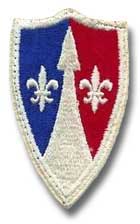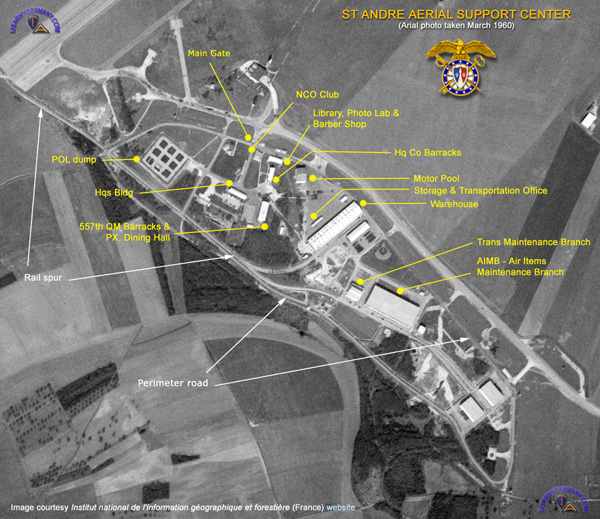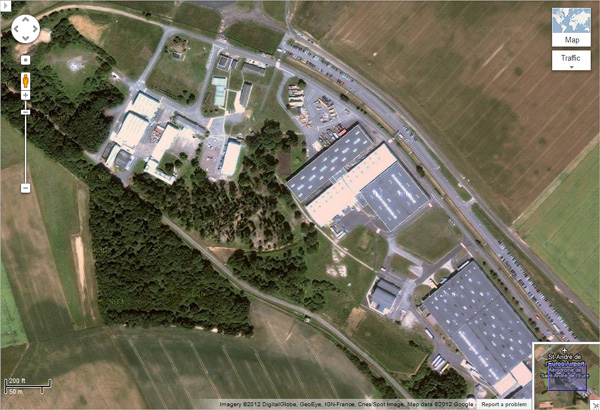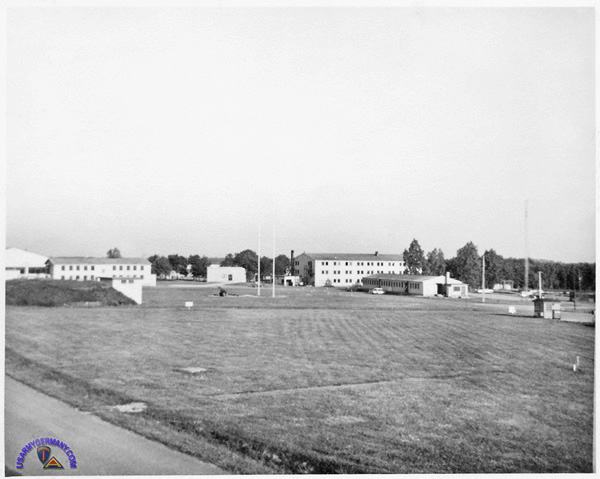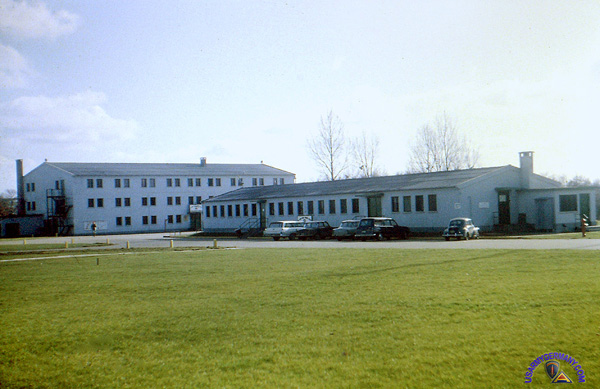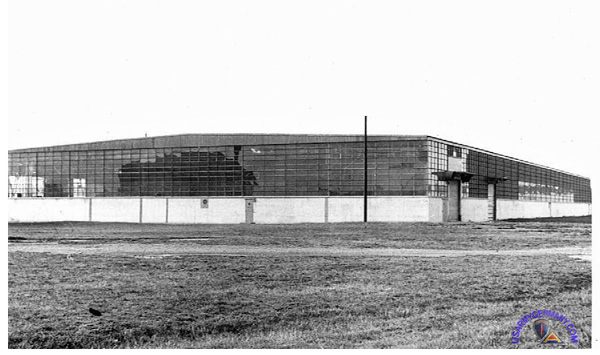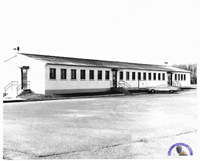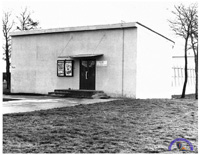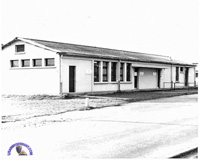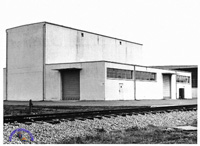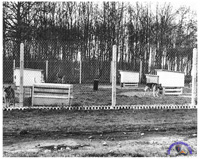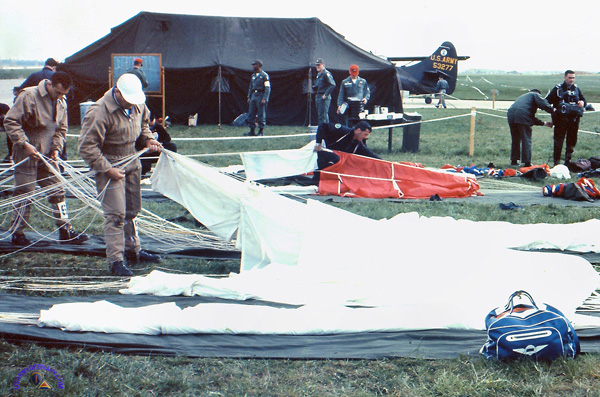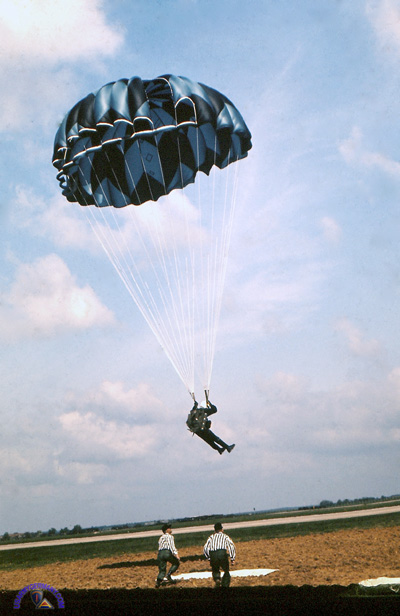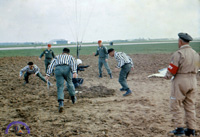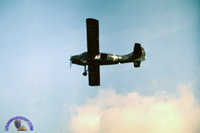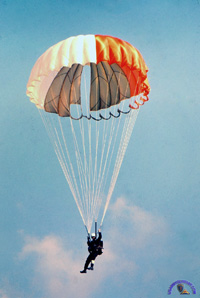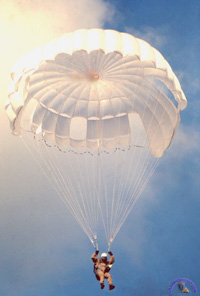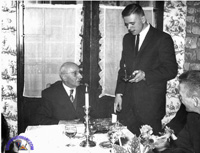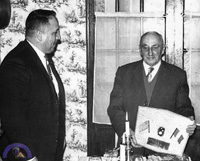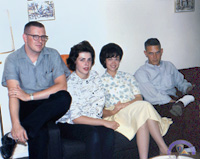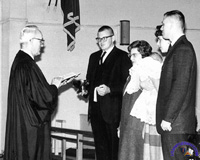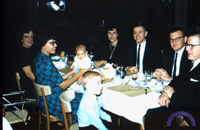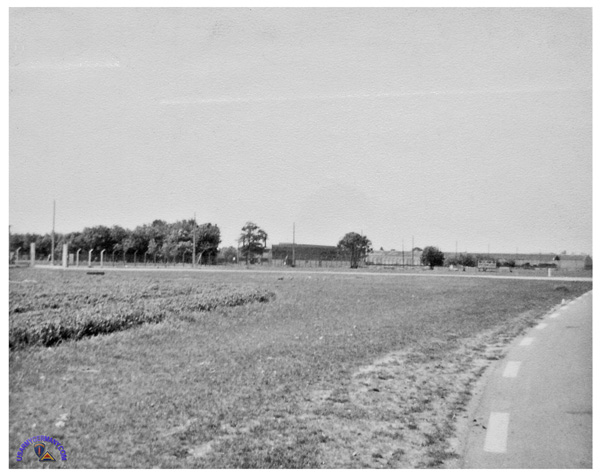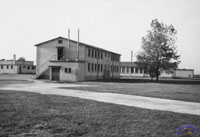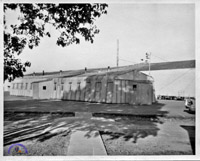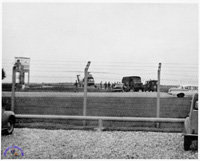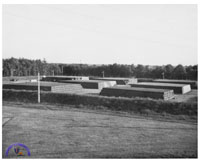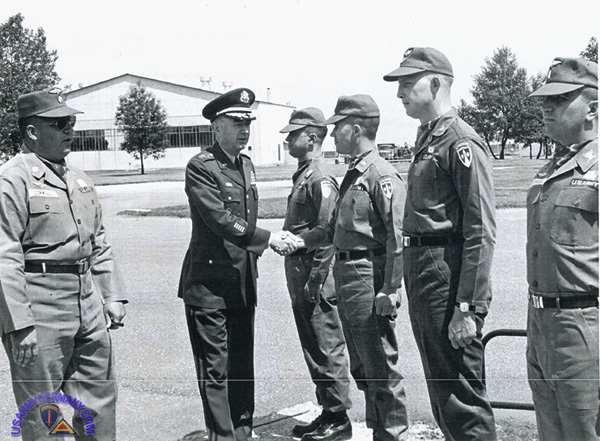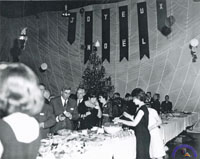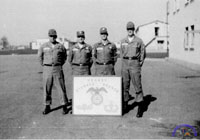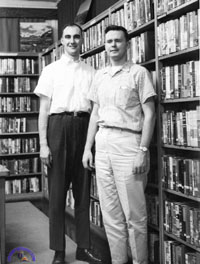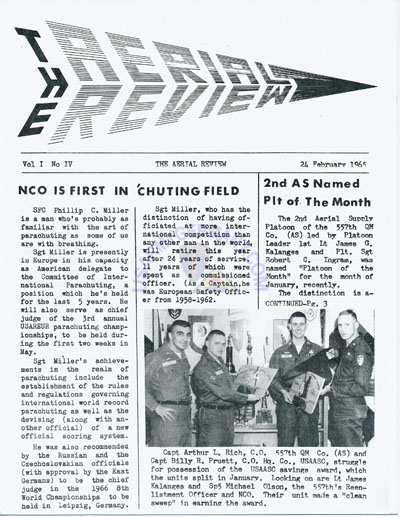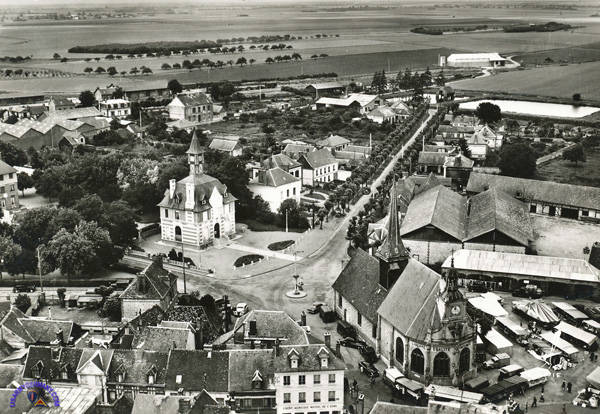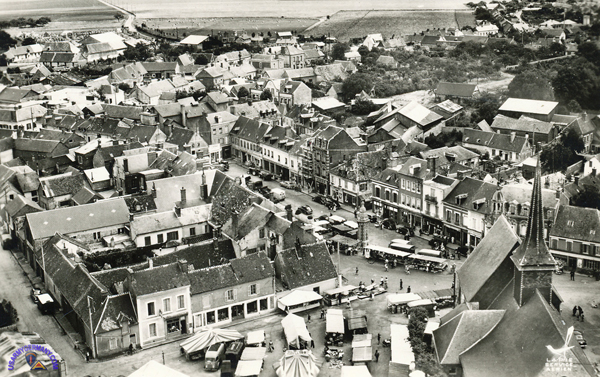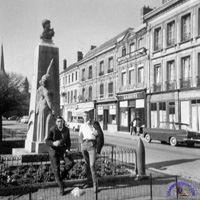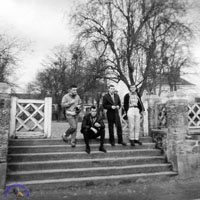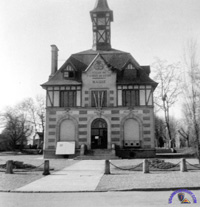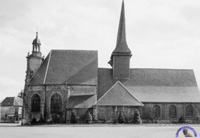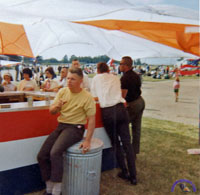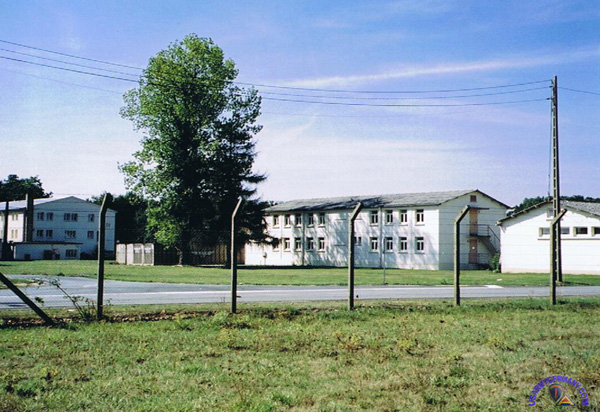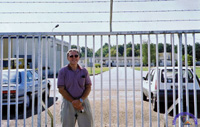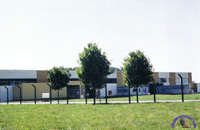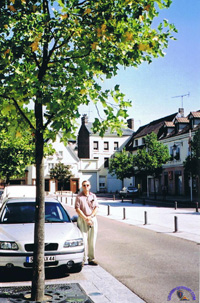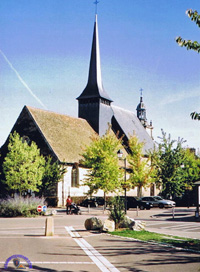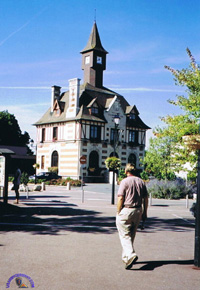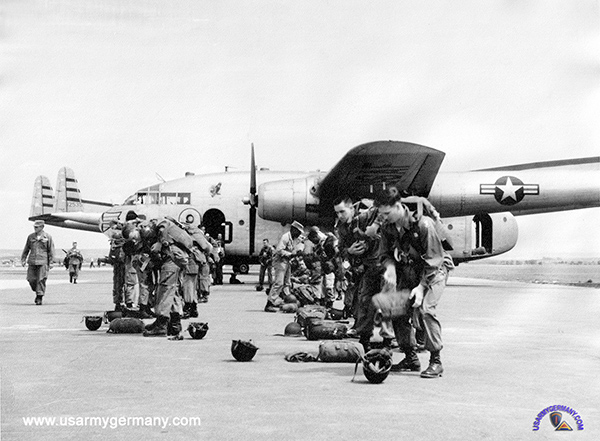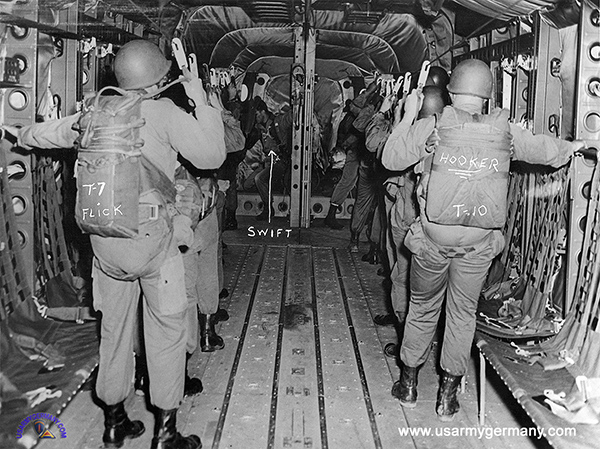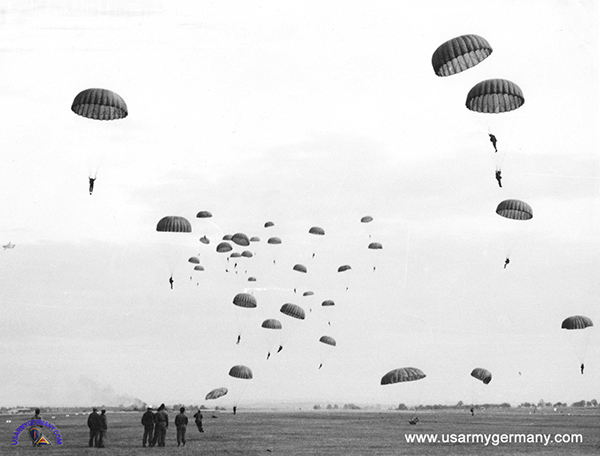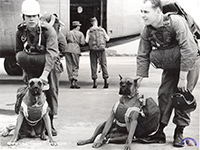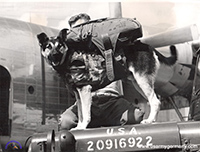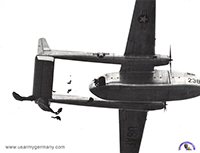| If you do NOT see the Table of Contents frame to the left of this page, then Click here to open 'USArmyGermany' frameset |
|||||||||||||||||
US Army Aerial Support Center |
|||||||||||||||||
|
|||||||||||||||||
| History of the US Army Aerial Support Center (7868th AU) | |||||||||||||||||
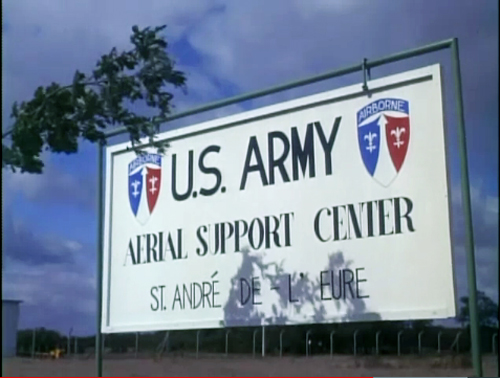 Sign on access road just before the main entrance (Big Picture video) |
|||||||||||||||||
| 1956 | |||||||||||||||||
| (Source : STARS & STRIPES, May 26, 1956) | |||||||||||||||||
| The US Army Quartermaster Depot at St. Andre de l'Eure, France opened on May 25, 1956. It is the first depot of its type in USAREUR. Depot commander is Lt Col Benjamin Sekowski. The depot's mission is to store all classes of supplies and prepare them for aerial delivery to NATO units. The depot is manned by the 7868th Army Unit, which trained at the Perigeux QM Depot and moved to St Andre earlier in the year. The 7868th will work with the 557th QM Company which is stationed at the Evreux Air Base (just north of St. Andre). The 557th is attached to the 7868th. (The 557th QM Co is composed of parachutists and is equipped to paradrop supplies. Planes for supply missions will operate out of the Evreux Air Base. At the time of the article, the 465th Troop Carrier Wing with 54 C-119 "Flying Boxcars" was stationed at the air base.) Construction of the depot was started in August 1954. The installation is located on a former French air base five miles southwest of the village of St. Andre de l'Eure (and about 50 miles west of Paris). All the buildings of the installation are new. They include a 116-man barracks with mess hall, PX, library, Special Services area, administration buildings, fire station, POL storage pads, warehouses and sheds. |
|||||||||||||||||
| 1963 | |||||||||||||||||
| (Source: Submitted by Jeff Melin via Raymond Turgeon) | |||||||||||||||||
| Jeff Melin was the S1/Adjutant from Dec 1963 through June 1965. | |||||||||||||||||
|
|||||||||||||||||
|
|||||||||||||||||
|
|||||||||||||||||
|
|||||||||||||||||
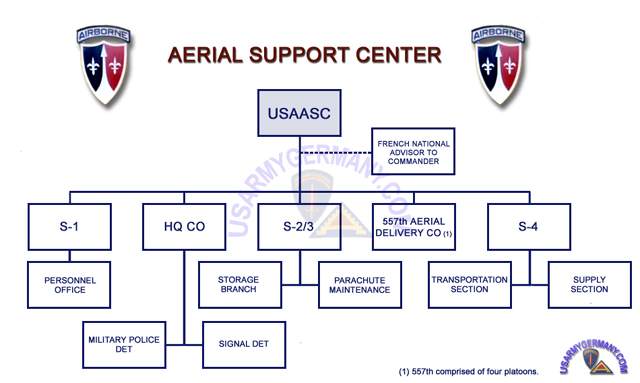 Organization chart (James Kalanges) |
|||||||||||||||||
| 1964 | |||||||||||||||||
| (Source: Email from Raymond Turgeon) | |||||||||||||||||
| I was stationed at the US Army Aerial Support Center in St. Andre de l'Eure, France from Feb 1964 until Aug 1966. I was the stock control supervisor. We also had a warehouse sergeant and OIC. In the AIMB -- I believe it was for the Air Items Maintenance Branch -- Parachutes were inspected, maintained and repaired. The rail spur entered the installation from the north/northwest as best as I can tell from the maps I've looked at and remembering walking back to the barracks from the AIMB with someone after a weightlifting session. We were looking at a beautiful sunset. There was a small theater between the barracks. It can be seen if you zoom in on the photo and the PX as mentioned previously to the right of it attached to the barracks. A weight room was added in the AIMB while I was there. There was a small bowling alley. There was a basketball court/tennis courts opposite the Quartermaster barracks. There was also a baseball diamond that can be seen in the aerial photo. The dog kennels were added while I was there and were near the two unmarked buildings, southeast of the AIMB. Housing for officers and personnel with dependents were located at Evreux Air Base. ADDITIONAL INFORMATION I found a different set of the photos that I previously sent to you. These had my “what-are-we-looking-at” entries on the back. The building that housed the library, photo lab and barber shop also housed a Security Office and a Day Room. As I mentioned previously, I was one of the librarians. I remembered that the photo lab was on one side and there was something on the other but forgot it was a Day Room. The “Quonset” huts that housed the Storage Branch and Transportation Offices also housed the Personnel Offices under a CWO Posey. There was an MP detachment and a Signal detachment (a detachment of the 275th Signal Co). They were in my barracks on the opposite end. It goes without saying that the canines were under the MPs. Lt. Jeffrey Melin told me that the fire station was opposite the MP shack at the entrance to the installation. The doors were facing the airfield. It was transformed into the NCO club with the moniker of “The Round Up Club.” The curtains, etc. had a wild west motif. He doesn’t remember what happened to the fire trucks. The logical destination would be the motor pool. Lt. James Kalanges was the Aerial Delivery Officer of the 557th then became my OIC at the Storage Branch. He became HQ CO Company Commander in December 1965 and was the last soldier to leave the installation in January 1967. He sent me some photos as well as copies of a few issues of “The Aerial Review,” our newspaper. He included a rough draft of an organization chart from memory (see above). I have also attached some additional photos. Some comments made to Raymond by Jim Kalanges about the annotated aerial photo of the installation from 1960: I think the 2 blgds at the end of the installation (bottom right of photo) were used for the storage of ammo to support the combat units on the front if we went to war and had to air drop supplies and equipment and supplies to the units in contact or special forces in the boonies ---- just as we stored rations (C's) and 5-gal gas cans and some 55 gal drums (Class 3). You will remember the huge job we had in maintaining the cans and drums painting and rotating them. We had guard dogs in the ammo warehouses. The MP's took care of the dogs. |
|||||||||||||||||
|
|||||||||||||||||
|
|||||||||||||||||
|
|||||||||||||||||
| (Source: Submitted by Mike Hinton via Raymond Turgeon) | |||||||||||||||||
| Mike Hinton was stationed at St. Andre de l'Eure from late 1964-66. His workplace was the storage office located in the AIM building. He worked with Raymond Turgeon. | |||||||||||||||||
|
|||||||||||||||||
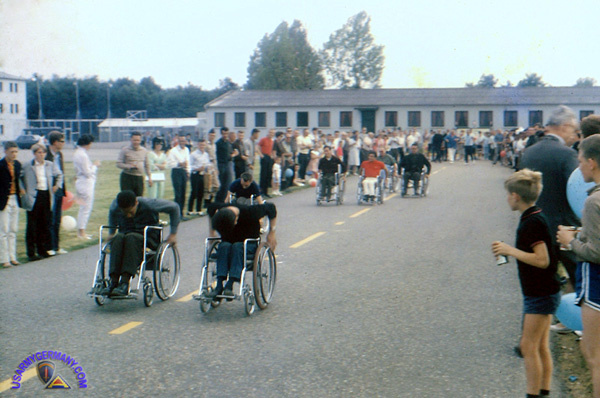 Wheelchair race, Fouth of July at USAASC (Jeff Melin) |
|||||||||||||||||
|
|||||||||||||||||
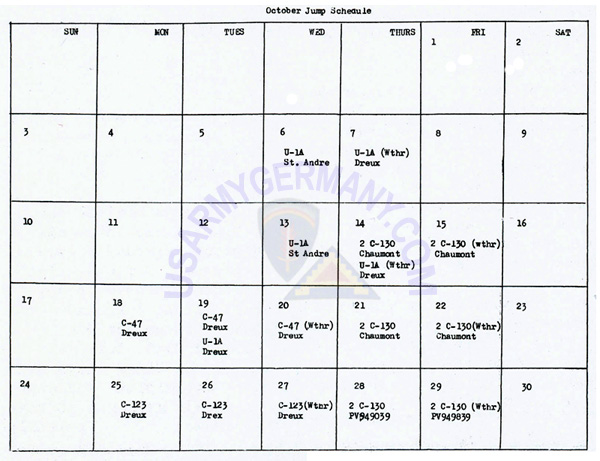 Jump schedule for October 1965 |
|||||||||||||||||
| (Source: Email from Raymond Turgeon) | |||||||||||||||||
| You had asked me about where the airborne troops went for their required jumps. One of the Areial Review pages that I received had the October (1965) Jump Schedule and most of them were at Dreux AB. Others at Chaumont. I attached it. | |||||||||||||||||
| 1966 | |||||||||||||||||
| (Source: STARS & STRIPES, Jan 6, 1966) | |||||||||||||||||
| On January 5, 1966 the US Army announced that it would close three bases in France, including the Aerial Support Center at St. Andre de l'Eure (west of Paris). (The other two bases were the US Army Depot Activity at Brienne-le-Chateau and the Ammunition Depot at Trois Fontaines.) These actions (and others) were being taken as part of a cost reduction program. The announcement went on to state that the St Andre installation would be inactivated by March 31. (There was some discussion about moving the activity to a new location, but no decision had been made as of the date of the announcement.) (An unrelated article that appeared in a May issue of the S&S mentioned that the 105mm howitzer that had been used at St Andre for retreat ceremonies, was moved to the Poitiers garrison -- Caserne Aboville -- where it continued to serve as a salute cannon during retreat ceremonies.) |
|||||||||||||||||
| 2003 | |||||||||||||||||
| (Source: Submitted by Jeff Melin via Raymond Turgeon) | |||||||||||||||||
| Capt Jeff Melin (Ret.) returned to St Andre for a visit of the former USAASC in 2003. Here are some of his photos of the visit. | |||||||||||||||||
|
|||||||||||||||||
| 557th Quartermaster Company (Aerial Supply) | |||||||||||||||||
| Munich / Nellingen, Germany (1951 - 1955) | |||||||||||||||||
| 1951 | |||||||||||||||||
| (Source: STARS & STRIPES, December 16, 1951) | |||||||||||||||||
| Until last summer, the aerial supply mission was primarily an Air Force responsibility. Now the Quartermaster Corps stores, packs and delivers supplies and equipment to troops while the Air Force supplies the planes and operational and maintenance crews. The 557th Aerial QM Supply Company, stationed in Munich and attached to the Munich QM Depot (Karlsfeld), practices its trade at Echterdingen Airfield near Stuttgart. Every member of the company is a jumper. They rig their own chutes as well as those used by the 6th Ranger Company and the light aviation sections in the European Command. The men of the 557th pack supplies in special air drop containers and then lash the supplies on plywood pallets. The pallet plays an important role as it absorbs a lot of the shock of hitting the ground at 22 feet per second. The cargo, oncle lashed to a pallet, is then loaded on rollers inside one of the "packet planes" of the Air Force. These planes - C82 and C119 - are designed especially for military air transport and air drops. Once over the drop area, a parachute billows open and drags the cargo out of the open rear of the plane. A second parachute, much larger than the first one, opens after the cargo clears the plane and the pallet floats down to earth for almost immediate use. |
|||||||||||||||||
| 1953 | |||||||||||||||||
| (Source: Email from Gerard Dupczak) | |||||||||||||||||
| My mother-in-law's second husband died a few years ago. He served with the 557th Quartermaster Company (Aerial Supply) in Germany in 1953. I have a small collection of photos and memorabilia that he kept. I've attached two scans. If there is interest in the collection, I will scan the rest of the items. |
|||||||||||||||||
|
|||||||||||||||||
| 1954 | |||||||||||||||||
| (Source: STARS & STRIPES, April 19, 1954) | |||||||||||||||||
| The 557th QM Aerial Supply Company is training additional members of French paratroop supply units. This time, three groups from the French 1st Air Trans Company stationed in Kehl, Germany will undergo the two-week course which includes packing of all types of cargo and rigging of parachutes. Also included will be training in flight safety, supply, heavy equipment loading, load computation and characteristics of aircraft. Similar courses have been conducted for other French units, as well as Italien and USAFE groups since the 557th's arrival in Europe in 1951. |
|||||||||||||||||
| 1955 | |||||||||||||||||
| (Source: STARS & STRIPES, Sept 15, 1955) | |||||||||||||||||
| The 557th QM Aerial Supply Company recently moved from Germany to their new base at Evreux Air Base in France. The unit packages and stores good for free-drops from aircraft. For the past two summers, the 557th has operated an aerial supply school to train French, Italian and Belgian members of NATO on the fundamentals of aerial-supply operations. |
|||||||||||||||||
| Evreux / St-Andre-de-l'Eure, France (1955 - 1966) | |||||||||||||||||
| Mainz-Gonsenheim, Germany (1966 - 1968) | |||||||||||||||||
| (Source: Email from Sam Samuels) | |||||||||||||||||
| During this time, the 557th QM Company (Aerial Delivery) was assigned to the Nahbollenbach Army Depot but co-located with 1st Battalion, 509th Infantry at Lee Barracks. | |||||||||||||||||
| Nahbollenbach, Germany (1968 - 1975) | |||||||||||||||||
| 1969 | |||||||||||||||||
| (Source: Email from Sam Samuels, former commanding officer of the 557th QM Company (Air Delivery), August 1969 - August 1970 | |||||||||||||||||
| 557 QM Company (Air Delivery) - Airborne Operations from Nahbollenbach Army Depot (NAD) From August 1969 to August 1970 I commanded the 557 Quartermaster Company (Air Delivery) assigned to Nahbollenbach Army Depot (NAD) at Idar-Oberstein Germany. The structure of a doctrinal Air Delivery Company was a company headquarters/operations office and four platoons (organized to operate independently if required in the same manner as an Air Delivery Detachment). Each platoon had a capability of providing 50 tons of air drop per day. The 557 was the only parachute resupply company in USEUCOM. The company’s mission was to provide resupply by parachute to USEUCOM units. At its authorized level of organization, the company could provide 150 tons of supplies and equipment by parachute. The doctrinal structure was a company headquarters/operations office and three platoons. Its rated capacity was 150 tons of airdrop per day. We had the staffing to support two platoons plus. Each of the platoons were amazing in that they had parachute riggers, ammunition specialists, petroleum specialists, and general supply specialists. Each platoon was multi-capacity organizations capable of receiving Class I, II, III (Packaged), IV, and V and preparing these supplies for airdrop. A platoon could operate independently but was dependent on other organizations for food, shelter, and administration. I could provide a mess specialist, vehicle mechanics, and clerks to a deploying platoon from company assets if required. The company had two missions at NAD – first to perform the air drop mission and the second to operate a packaged petroleum storage site of Fog Oil. The Fog Oil was stored in 55-gallon drums (To read more about Fog Oil, click here.) The platoons rotated between the air drop mission and the petroleum storage mission. In Early 1970, the Allied Command Europe conducted Exercise Artic Express at Narvik in northern Norway. The 557 was invited to support the exercise. We sent one platoon complete with both Rigger and non-Rigger personnel. When the platoon returned it came with several letters of commendation and a funny story. One day the platoon had a casualty. One of the soldiers said he was suddenly stricken blind. When he awoke from he couldn’t see. He was taken to the doctor who couldn’t find any reason for the blindness, so he prescribed bed rest in a dark room. After two days the soldier returned to normal sight and duty. It seems that emergency airdrop missions always come at meal times causing the troops to miss their chow. If the troops are rigging out food, it is not unknown for some of it to be diverted. One day the platoon leader was grabbed by an Italian Infantry Captain who was livid. It seems that when the unit received its food by parachute some of the bottles of fire starter was missing. Thus, we found the reason for the soldier’s blindness. In early September 1970, one platoon of the 557 had been deployed to Leghorn Army Depot at Livorno, Italy to rigout follow-on supplies in support of the 1st Bn, 509th Airborne Infantry. The 1/509 was normally stationed at Lee Barracks in Mainz, Germany but had jumped into Turkey in support of a NATO Exercise. After the airdrop of the supplies the platoon returned to NAD. At the same time, King Hussein of Jordan was forced to try to throw the Palestine Liberation Organization’s fighters (fedayeen) out of the country. It was a difficult task and, at first, it seemed that the fedayeen would win. The King requested help. President Nixon decided to send in the 1/509 from Germany and the 82nd Airborne from the US mainland to protect US personnel and interests. The 1/509 was redeployed from Turkey leaving their airdrop equipment and parachute riggers behind to recover them. A platoon of the 557 was sent to Mainz to rigout the 1/509 which took about 4 days. One platoon at NAD packed the parachutes for the 509 and expanded the honeycomb impact reducer for the riggers at Mainz. The third platoon operated POL hill. On Friday of the week after rigout of the 1/509 I received a call late evening call to report to the Headquarters Company. I was met by the Depot Commander who gave me a message from HQ USAMATCOMEUR. The message directed the 557 to begin to rigout follow-on supplies for the 1/509th and the 82nd Airborne which, unbeknown to us, was going to follow the 1/509th. We were to prepare Class I (food and water) and Class II and IV items at NAD. We were to prepare Ammunition to Miesau Army Ammunition Depot and packaged petroleum products (Class IIIP) at Hinterweidenthal Tank Farm. The platoon at NAD was tasked with rigging out the Class I and packing cargo parachutes in support of the entire company. We operated at the rate of 150+ tons per day. Of course, while this was going on, the Depot was notified that it would have its Annual General Inspection. The USAREUR IG was an old airborne colonel so I was asked to brief him on our ongoing operation. I did and, at the end told him that his people were free to look at any administrative area of the company BUT if his people woke any soldier of mine who was asleep I would break their necks. The IG supported me on this but the Depot Command staff were aghast. The USAREUR IG was an old 82nd Airborne soldier and knew where I was coming from. At exit briefing of the Depot IG the Colonel said that the 557 was excellent in all administrative respects BUT, he knew that the Commander of the 557 would appreciate the full treatment so the team would come back when we were recovered from the operation. I said, “Don’t do me any f***ing favors.” When they came back we passed with flying colors. Between the two annual general inspections, the US Government decided to provide field hospitals rather than combat soldiers. That left us with a brigade’s worth of equipment rigged out and ready to drop. I recommended that we activate French Drop zone at Baumholder. I had the Air Force certify the drop zone in 1970 so, to the brigade’s surprise the Air Force agreed. The NAD Commander told me that it was neat that we would drop the 1/509 equipment but that the 557 had “no skin in the game.” I told him that I would drop my jeep and if there were no malfunctions he could ride home with me. On the day of the drop there were no malfunctions and the colonel and I drove home in the open jeep. Later that year we received a message that started from the Secretary of State commending the Army in Europe for their support of the operation. Our company was singled out in the USTASCOMEUR section of the message. So, when I turned over the company we had successfully completed a Command Maintenance Management Inspection (CMMI), a USAREUR IG Inspection, and an Operational Readiness Test (the support to Black September) which also counted at an Army Training Test. Not a bad run. ADDITIONAL INFORMATON #1 As to the maps of Strassburg Kaserne: Building 9001 - Hq Det NAD and the 522 QM Co (think they worked the subsistence mission in the Depot) Building 9002 - 85th QM Company (Depot Operations) Building 9003 - 557 QM Company (Air Delivery) Building 9004 - 9th (?) Combat Equipment Company As you came through the Main Gate, to your right was Headquarters Company, then the 85th QM Co., then it was the 522nd QM Co., 557th Airborne, and next to them were billets but I am not sure for whom, maybe POL personnel. Directly across from the 522nd was the Mess Hall. Huge structure. Also had a dry cleaners and some other vendors, maybe a Barbershop, not sure. |
|||||||||||||||||
| 1971 | |||||||||||||||||
| (Source: STARS & STRIPES, May 25, 1971) | |||||||||||||||||
| The red-hatted riggers of the 557th Quartermaster Company (Air Delivery), stationed at Nahbollenbach, have a primary mission of parachute-packing and the temporary storing and rigging of supplies and equipment for airdrops by any of the services. The company also provides technical assistance and training on air delivery missions with NATO nations. |
|||||||||||||||||
| 1975 | |||||||||||||||||
| (Source: STARS & STRIPES, July 9, 1975) | |||||||||||||||||
| On June 30, 1975 the 557th Quartermaster Company (Air Delivery) was inactivated at Kaiserslautern. Concurrently, the 5th QM Detachment was activated and assumed the 557th's former mission. The 557th was composed of three platoons with a total of 116 military personnel. The company's mission was to perform parachute packing and rigging of supplies and equipment for air drops by US forces. The 5th detachment has only one platoon. About half of the company is being transferred to the new detachment. To commemorate the inactivation, the personnel of the 557th made a last jump along with the German 3rd Company, 261st Airborne Battalion (partnership unit?) in a field near Kaiserslautern. |
|||||||||||||||||
| Related Links: |
|||||||||||||||||
